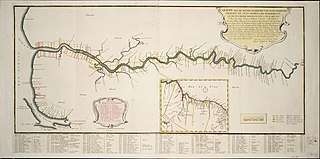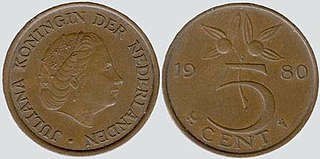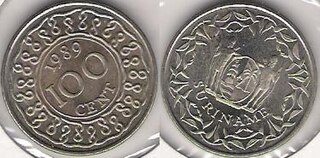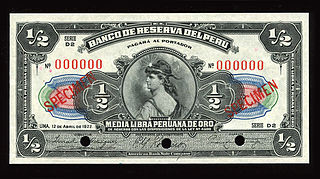The Eastern Caribbean dollar is the currency of all seven full members and one associate member of the Organisation of Eastern Caribbean States (OECS). The successor to the British West Indies dollar, it has existed since 1965, and it is normally abbreviated with the dollar sign $ or, alternatively, EC$ to distinguish it from other dollar-denominated currencies. The EC$ is subdivided into 100 cents. It has been pegged to the United States dollar since 7 July 1976, at the exchange rate of US$1 = EC$2.70.

British Guiana was a British colony, part of the mainland British West Indies, which resides on the northern coast of South America. Since 1966 it has been known as the independent nation of Guyana.
The British West Indies dollar (BWI$) was the currency of British Guiana and the Eastern Caribbean territories of the British West Indies from 1949 to 1965, when it was largely replaced by the East Caribbean dollar, and was one of the currencies used in Jamaica from 1954 to 1964. The monetary policy of the currency was overseen by the British Caribbean Currency Board (BCCB). It was the official currency used by the West Indies Federation The British West Indies dollar was never used in British Honduras, the Cayman Islands, the Turks and Caicos Islands, the Bahamas, or Bermuda.

Demerara is a historical region in the Guianas, on the north coast of South America, now part of the country of Guyana. It was a colony of the Dutch West India Company between 1745 and 1792 and a colony of the Dutch state from 1792 until 1815. It was merged with Essequibo in 1812 by the British who took control. It formally became a British colony in 1815 until Demerara-Essequibo was merged with Berbice to form the colony of British Guiana in 1831. In 1838, it became a county of British Guiana until 1958. In 1966, British Guiana gained independence as Guyana and in 1970 it became a republic as the Co-operative Republic of Guyana. It was located around the lower course of the Demerara River, and its main settlement was Georgetown.

The Trinidad and Tobago dollar is the currency of Trinidad and Tobago. It is normally abbreviated with the dollar sign $, or alternatively TT$ to distinguish it from other dollar-denominated currencies. It is subdivided into 100 cents. Cents are abbreviated with the cent sign ¢, or TT¢ to distinguish from other currencies that use cents. Its predecessor currencies are the Trinidadian dollar and the Tobagonian dollar.

The Guyanese dollar has been the unit of account in Guyana since 29 January 1839. Originally it was intended as a transitional unit to facilitate the changeover from the Dutch guilder system of currency to the British pound sterling system. The Spanish dollar was already prevalent throughout the West Indies in general, and from 1839, the Spanish dollar unit operated in British Guiana in conjunction with British sterling coins at a standard conversion rate of one dollar for every four shillings and twopence. In 1951 the British sterling coinage was replaced with a new decimal coinage which was simultaneously introduced through all the British territories in the Eastern Caribbean. When sterling began to depreciate in the early 1970s, a switch to a US dollar peg became increasingly attractive as an anti-inflationary measure and the Eastern Caribbean Currency Authority made the switch in October 1975. The Guyanese dollar is normally abbreviated with the dollar sign $, or alternatively G$ to distinguish it from other dollar-denominated currencies.

The rupia was the currency of Portuguese India sometime after 1668 until 1958. Prior to 1668, the currency unit was Xerafim. In 1666, the Portuguese administration struck a silver coin calling it double xerafin and this was declared equal to a rupia in circulation in India outside of Portuguese possessions. A xerafim was a convertible subunit of rupia, and it was unique to Portuguese colonies in India. One rupia equalled two xerafims.

The Guianas, also spelled Guyanas or Guayanas, is a region in north-eastern South America. Strictly, the term refers to the three Guyanas: Guyana, Suriname and French Guiana, formerly British, Dutch and French Guyana. Broadly it refers to the South American coast from the mouth of the Oronoco to the mouth of the Amazon.

Berbice is a region along the Berbice River in Guyana, which was between 1627 and 1792 a colony of the Dutch West India Company and between 1792 and 1815 a colony of the Dutch state. After having been ceded to the United Kingdom of Great Britain and Ireland in the latter year, it was merged with Demerara-Essequibo to form the colony of British Guiana in 1831. It became a county of British Guiana in 1838 till 1958. In 1966, British Guiana gained independence as Guyana and in 1970 it became a republic as the Co-operative Republic of Guyana.

The stuiver was a coin used in the Netherlands, worth 1⁄20 Dutch Guilders. It was also minted on the Lower Rhine region and the Dutch colonies. The word can still refer to the 5 euro cent coin, which has almost exactly the same diameter and colour despite being over twice the value of the older coin.

The real was the unit of currency of Portugal and the Portuguese Empire from around 1430 until 1911. It replaced the dinheiro at the rate of 1 real = 840 dinheiros and was itself replaced by the escudo at a rate of 1 escudo = 1000 réis. The escudo was further replaced by the euro at a rate of 1 euro = 200.482 escudos in 2002.

Essequibo was a Dutch colony in the Guianas and later a county on the Essequibo River in the Guiana region on the north coast of South America. It was a colony of the Dutch West India Company between 1616 and 1792 and a colony of the Dutch state from 1792 until 1815. It was merged with Demerara in 1812 by the British who took control. It formally became a British colony in 1815 until Demerara-Essequibo was merged with Berbice to form the colony of British Guiana in 1831. In 1838, it became a county of British Guiana till 1958. In 1966, British Guiana gained independence as Guyana and in 1970 it became a republic as the Co-operative Republic of Guyana. It was located around the lower course of the Essequibo River.

The guilder was the currency of Suriname until 2004, when it was replaced by the Surinamese dollar. It was divided into 100 cents. Until the 1940s, the plural in Dutch was cents, with centen appearing on some early paper money, but after the 1940s the Dutch plural became cent.

The Netherlands Indies guilder was the unit of account of the Dutch East Indies from 1602 under the United East India Company, following Dutch practice first adopted in the 15th century. A variety of Dutch, Spanish and Asian coins were in official and common usage. After the collapse of the VOC at the end of the 18th century, control of the islands reverted to the Dutch government, which issued silver 'Netherlands Indies' guilder and fractional silver and copper coins until Indonesian independence in 1945.
The guilder was the currency of British Guiana between 1796 and 1839.

The dollar was the currency of the colony of Newfoundland and, later, the Dominion of Newfoundland, from 1865 until 1949, when Newfoundland became a province of Canada. It was subdivided into 100 cents.

The Colony of Demerara-Essequibo was created on 28 April 1812, when the British combined the colonies of Demerara and Essequibo into the colony of Demerara-Essequibo. They were officially ceded to Britain on 13 August 1814. On 20 November 1815 the agreement was ratified by the Netherlands. On 21 July 1831 Demerara-Esequibo united with Berbice as British Guiana.

The Peruvian gold pound, was a unit of currency issued in Peru between 1898 and 1931. It was fixed in value to 10 soles and was issued in the form of gold coins and banknotes, which circulated alongside coins denominated in centavos, dineros and soles. The gold pound was equal to the British sovereign.

The Dutch West Indies campaign was a series of minor conflicts in 1781 and 1782, in the Fourth Anglo-Dutch War and the American Revolutionary War. Following Great Britain's declaration of war on the Dutch Republic in December 1780, British Admiral George Brydges Rodney, the commander of the Royal Navy in the West Indies, was notified by a fast-sailing packet ship of the declaration. He immediately acted to ensure control over as many of the Dutch colonies as possible, capturing Sint Eustatius, a vital entrepot of French and Dutch trade between their colonies and Europe, in early February 1781. He also captured Saba and Sint Maarten, and orchestrated the capture of the Dutch colonial outposts of Berbice, Demerara, and Essequibo in South America. A planned expedition by Samuel Hood against Curaçao was called off on rumors that a French fleet was approaching. A French expedition in 1782 captured Demerara and Essequibo, although the fate of the other colonies were settled at the conclusion of the war.

The capture of Demerara and Essequibo was a French military expedition carried out in January 1782 as part of the American Revolutionary War. In 1781 Admiral Lord Rodney sent two sloops from his fleet at Sint Eustatius to take possession of the Dutch colonies of Essequibo and Demerara. In 1782 the French successfully took possession of these settlements, compelling British Governor Robert Kingston to surrender. The Treaty of Paris in 1783 restored these territories to the Dutch.





















